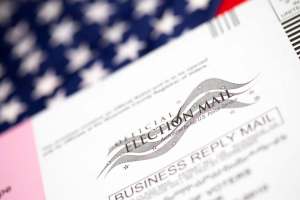Pennsylvania opens mail-in ballot applications for presidential election two months early

The Pennsylvania Department of State launched its mail-in ballot application on Tuesday, two months earlier than in 2020, giving voters more than eight weeks of additional time to apply for their absentee ballots.
The state piloted its redesigned mail-in envelopes during the April primary election, which may have contributed to a steep drop in mail-in ballots rejections due to technical errors, according to Pennsylvania Secretary of State Al Schmidt, who last month told the Associated Press that counties reported a 13.5% decrease in rejected mail-in ballots, compared to the 2023 primary election.
“The Shapiro Administration is focused on commonsense, practical ways to improve the vote-by-mail experience for voters. That includes design changes to mail ballot materials, which resulted in fewer mail ballots being rejected in April’s primary election,” Schmidt said in a statement about early application portal.
Common mistakes voters make on mail-in ballots include missing or incorrect dates, signature discrepancies and failing to insert ballots into their “secret” envelopes, an omission that forces election officials to toss out votes.
“In each election cycle since 2020, when no-excuse mail-in voting was implemented in Pennsylvania, we have seen thousands of mail ballots not be counted because of unintended technical errors voters made when completing their ballot,” Schmidt said in the November announcement. ”Our hope is that these new materials will better assist voters in making sure their completed mail ballot packet is filled out correctly and can be counted.”
In the 2023 primary, Pennsylvania counties rejected about 17,000 mail ballots, or 2.8% of the 597,000 mail-in and absentee ballots cast, according to the Department of State. Approximately 21,800 mail ballots were rejected in the 2020 general election, and about 23,700 mail ballots were rejected in the 2022 general election.
The new envelopes for mail-in ballots include a redesigned secrecy sleeve, a paper intended to protect voter privacy by separating identities and signatures from ballots. Pennsylvania is one of 19 states that requires election officials to provide secrecy sleeves to voters choosing to vote by mail.
Voters put completed ballots in secret envelopes into return envelopes with a yellow background, with watermarking to discourage stray marks. Each mail-in ballot also includes full-page instructions with graphics illustrating the order of envelope placement.
The new mail-in ballots also incorporate color-coding, highlighting fields voters must complete, such as signature and date. Purple outer return envelopes help post office employees easily identify and deliver ballots mailed close to Election Day.
A pre-filled number “20” at the beginning of the year on the outer envelope encourages voters to write the current date, not their birthdates, in that field.





